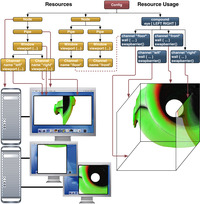Equalizer applications are configured at run-time using a hierarchically structured configuration to describe the available resources, display environment and the combination of the resources for rendering. Equalizer applications can either be configured automatically or using a static configuration file provided at launch time.
The example configuration on the right side shows a four-sided Virtual Reality installation running in stereo. The first part of the configuration declares the resources to be used, in this case two machines (nodes), three graphic cards (pipes), three windows and four channels. The second part, the compound tree, uses the resources for rendering, in this case to render onto the four walls. The root compound declare the usage of the left and right eye for stereo rendering, and the leaf compounds, which execute the rendering, use a swapbarrier to synchronize their output.
Chromium will be integrated with the Equalizer framework to provide a transparent execution layer. The Equalizer server will drive customized Chromium SPUs according to the selected configuration, just as any other Equalizer application. This transparent layer enables the execution and load-balancing of legacy and performance-uncritical applications alongside with scalable Equalizer applications.



